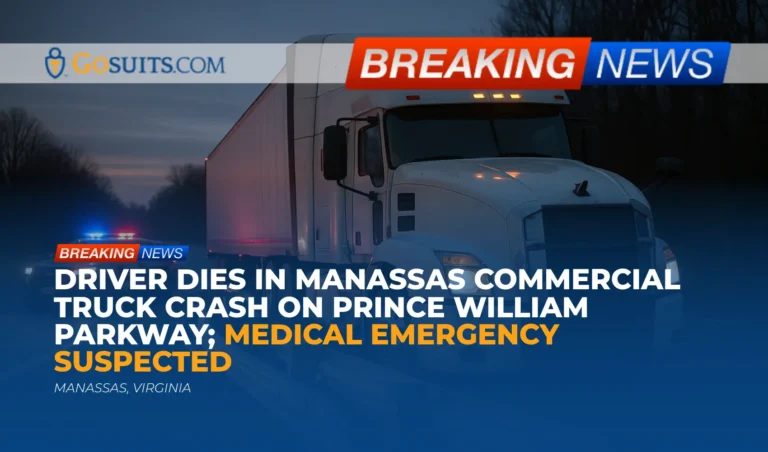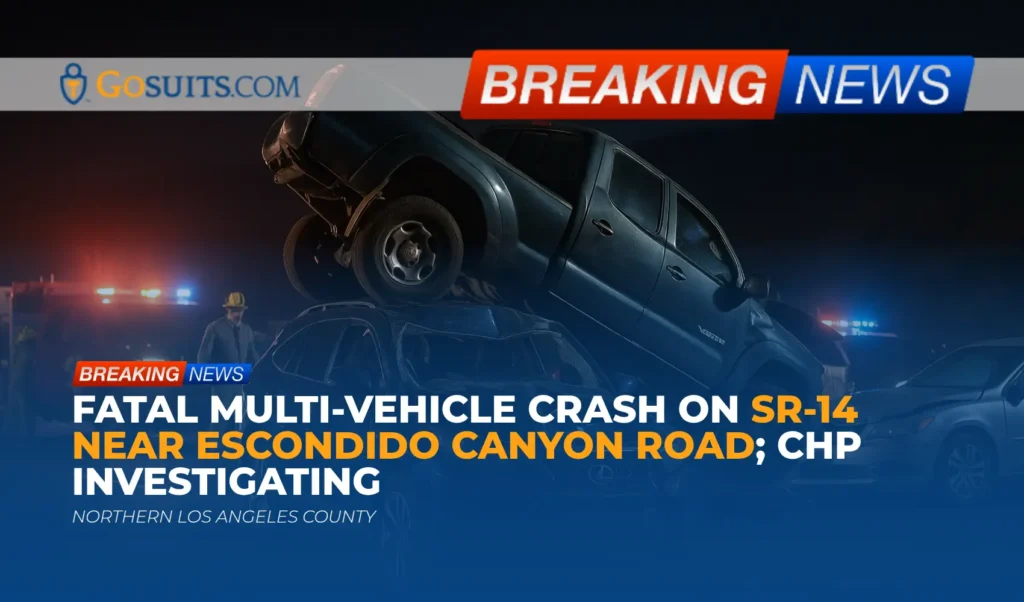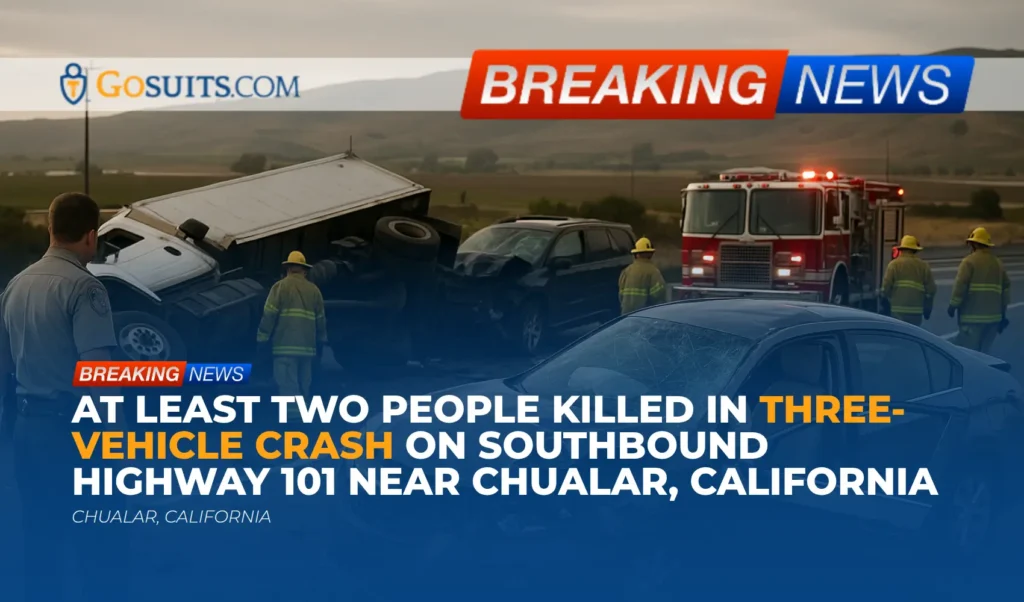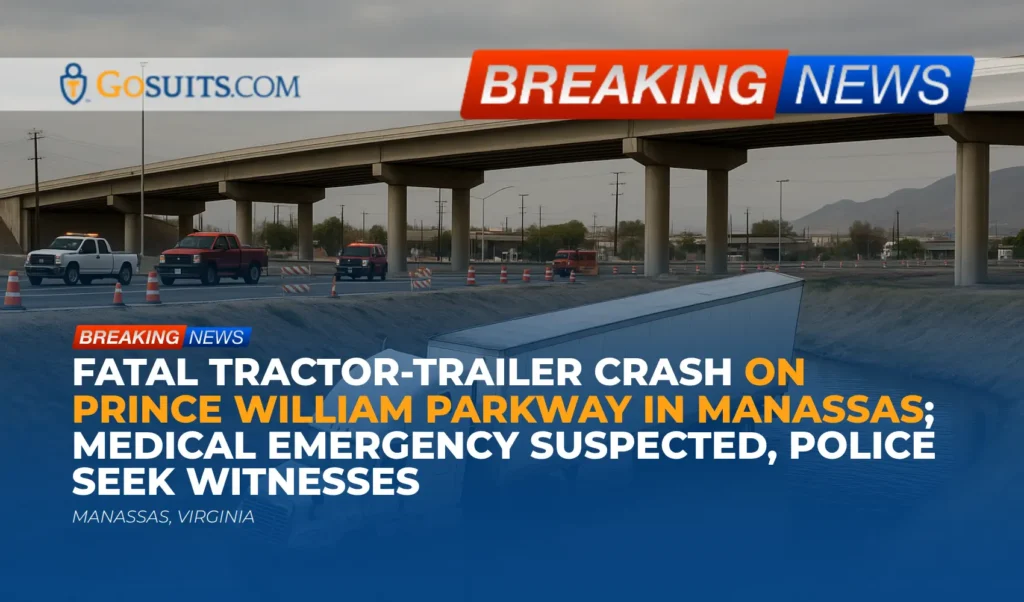- What happened in the Manassas crash
- Understanding single-vehicle commercial truck crashes
- Medical emergency and commercial driver fitness
- Key evidence to preserve after a commercial truck fatality
- Where families can get official records in Virginia
- Civil legal pathways that may apply
- Practical steps for loved ones after a fatal truck crash
- Safety and community considerations near Prince William Parkway
- Commentary from Gosuits Manassas, Virginia Personal Injury Attorney
- Why taking action soon matters
What happened in the Manassas crash
According to information released by the Prince William County Police Department, a 35-year-old commercial driver from California was killed in a single-vehicle crash early Sunday morning in Manassas. Officers responded around 4:45 a.m. to the area of Prince William Parkway and Hansen Farm Road. The initial investigation indicated that the driver of a 2022 Mack Anthem truck was traveling east, left the roadway onto the right shoulder, and struck a guardrail. The driver was transported to a hospital and later died. Police said it is believed the driver may have suffered a medical emergency prior to the crash. Witnesses were asked to share any information with law enforcement.
Location and timeframe
The crash occurred near the intersection of Prince William Parkway and Hansen Farm Road in Prince William County, Virginia, during pre-dawn hours. Low-light conditions and quiet roadways at that time of day often make witness identification more challenging, which is why any dash camera footage from other motorists in the vicinity can be especially valuable.
Vehicle and driver
The vehicle involved was a 2022 Mack Anthem, a heavy commercial truck model commonly used for regional and long-haul freight. The driver, identified publicly by police, was from Turlock, California. It is not publicly known from the initial report whether the driver was operating under a motor carrier’s authority at the time or whether the vehicle was loaded. Those details typically become available as investigators review company records and electronic data from the truck.
Preliminary police findings
Investigators noted a single-vehicle roadway departure with a subsequent guardrail impact. When a medical event is suspected, investigators generally work with the medical examiner and review the driver’s medical certification status, medication history (if any), and electronic logging device data to understand driving hours and rest patterns leading up to the incident.
Witness outreach
Law enforcement asked anyone with information to come forward. Individuals who drove through the area around the time of the crash and who may have dash camera footage can help investigators establish speed, lane position, lighting conditions, and whether any external factors contributed.
Understanding single-vehicle commercial truck crashes
Single-vehicle truck crashes can have many causes, and it often takes a thorough investigation to separate what appears likely from what can be proven. Contributing factors may include health-related events, driver fatigue, distraction, mechanical issues such as tire or brake failure, roadway conditions, and sudden evasive maneuvers.
For broader context, national fatal crash data are maintained through the Fatality Analysis Reporting System maintained by the National Highway Traffic Safety Administration, which aggregates multi-year information on roadway deaths and contributing factors across the United States. Publicly available summaries can be found through NHTSA’s FARS program. While national data cannot determine fault in an individual crash, it helps families understand how often certain factors are present in heavy vehicle roadway departures.
Commercial operations, rest, and duty status
If the truck was being operated for work, federal hours-of-service rules and electronic logging requirements may be relevant to the timeline. The Federal Motor Carrier Safety Administration provides an overview of hours-of-service rules and electronic logging devices on its website at Hours of Service (HOS) and ELD. These records, along with dispatch and fuel receipts, can help reconstruct the driver’s schedule before the incident.
Medical emergency and commercial driver fitness
Police stated they believe the driver may have experienced a medical emergency. In commercial transportation, driver medical fitness is regulated. Federal law requires interstate commercial drivers to meet medical qualification standards and hold a current medical examiner’s certificate. The core standards are listed at 49 C.F.R. § 391.41, and FMCSA’s medical program information is available at Driver Medical Requirements.
From a civil liability perspective in roadway cases, a sudden and unforeseeable medical incapacitation can complicate questions of negligence. Whether a medical event was truly sudden and whether warning signs existed are fact-specific determinations that may involve medical records, prescription histories, prior episodes, and the status of the driver’s medical certification at the time of the crash. In commercial operations, additional layers of responsibility can be implicated, such as the motor carrier’s duty to ensure its drivers are qualified and medically certified and to evaluate reported symptoms.
Why this matters for families
When a medical event is suspected, it is especially important that investigators and, when appropriate, family representatives obtain and review the medical examiner’s findings and relevant medical history. Those records can clarify what happened and whether the incident might involve employer obligations, occupational benefits, or other civil remedies.
Key evidence to preserve after a commercial truck fatality
Important evidence can begin to disappear within days or weeks. When a heavy truck is involved, several categories of records are time-sensitive.
Electronic logging device (ELD) and hours-of-service data
ELD data and related hours-of-service records can show when the driver was on duty, driving, or off duty. Federal regulations require carriers to retain certain records for limited periods. For example, driver records of duty status are subject to retention rules noted in 49 C.F.R. § 395.8. Early preservation requests help ensure this data is not overwritten or purged during routine system cycles.
Truck electronic control module (ECM), telematics, and cameras
Many modern tractors record speed, throttle position, engine load, brake application, fault codes, and other parameters through an ECM or telematics platform. Some carriers also use forward-facing and inward-facing cameras. Prompt, written preservation requests can help secure raw data before the vehicle is repaired or placed back in service.
Inspection and maintenance records
Carriers must systematically inspect, repair, and maintain vehicles used in interstate commerce, and they must preserve records of inspection and repair. These requirements are outlined in 49 C.F.R. § 396.3 and driver vehicle inspection report provisions at 49 C.F.R. § 396.11. Reviewing these records can reveal whether any mechanical condition could have contributed to roadway departure or control loss.
Scene documentation and public records
Scene photographs, measurements, and guardrail condition assessments can be important. Because this collision involved a guardrail, documentation of the rail type, condition, and any prior impacts may be relevant. Broader information on roadside hardware and safety performance is published by the Federal Highway Administration at FHWA Roadside Hardware. Public records requests can also secure 911 call audio, CAD logs, and any available traffic camera footage.
Where families can get official records in Virginia
For families seeking clarity, official records provide the most reliable picture of what occurred. The following government resources explain how to request key documents.
Police crash report
In Virginia, official police crash reports are maintained by the Virginia Department of Motor Vehicles. Instructions for obtaining a copy are available at the Virginia DMV’s records portal at dmv.virginia.gov. The local agency that investigated this crash is the Prince William County Police Department; their main page is at pwcva.gov/department/police. Contacting the department’s crash investigations unit with the date, location, and parties involved can help locate the report number for a DMV request.

Medical examiner, autopsy, and toxicology
Virginia uses a statewide medical examiner system. Next of kin can learn about case status and the process for requesting autopsy or toxicology reports through the Office of the Chief Medical Examiner at the Virginia Department of Health: vdh.virginia.gov/medical-examiner. The medical examiner’s findings often address cause and manner of death and may note natural disease processes if a medical event occurred.
Death certificates
Certified death certificates can be ordered through the Virginia Department of Health’s Vital Records office. Eligibility and application options are explained at vdh.virginia.gov/vital-records. Insurance and estate processes typically require certified copies.
911 audio, dispatch records, and other local records
Emergency communications records may be requested under Virginia’s Freedom of Information Act provisions, subject to exemptions. Prince William County’s FOIA guidance is posted at pwcva.gov/department/communications/foia. Requests should identify the date, time, intersection, and nature of the records sought (for example, 911 audio, CAD logs, or unit logs).
If the crash was work-related: OSHA/VOSH reporting
If the crash occurred in the course of employment, the employer may be required to report the fatality within eight hours to Virginia Occupational Safety and Health (VOSH), since Virginia operates a state occupational safety and health plan. Reporting and guidance are available through the Virginia Department of Labor and Industry at doli.virginia.gov/virginia-osha. Federal OSHA’s general reporting page is at osha.gov/report. These reports are distinct from police crash reports and may contain workplace safety context.
Civil legal pathways that may apply
Families often want to know what civil remedies might be available after a fatal crash. The answer depends on many facts, including whether the driver was working, what insurance policies apply, and whether any third party’s conduct contributed to the incident. The points below are general and intended to help frame the discussion with a qualified professional.
Wrongful death in Virginia
Virginia’s wrongful death statutes outline who may bring a claim, which beneficiaries may recover, and the time limits for filing. Under Virginia law, a wrongful death action is brought by the decedent’s personal representative for the benefit of statutory beneficiaries. See Va. Code § 8.01-50 et seq.. The general time limit for filing a wrongful death action is two years from the date of death; see Va. Code § 8.01-244. Establishing a personal representative through the appropriate court is an important early step because the representative is the party authorized to bring the civil action.
Workers’ compensation death benefits
If the driver was in the course and scope of employment at the time of the crash, workers’ compensation may provide death benefits to eligible dependents. The Virginia Workers’ Compensation Commission provides guidance for injured workers and families at vwc.virginia.gov. Filing deadlines apply; for work injuries in Virginia, claims generally must be filed with the Commission within two years, though specific timelines and requirements can vary by circumstance. Multi-state employment can introduce additional jurisdictional questions, and it may be important to evaluate whether claims should be made in more than one state depending on the employment relationship and where the injury occurred.
Third-party liability possibilities
Even in a single-vehicle crash, it can be appropriate to assess whether other parties may bear responsibility, such as:
- Vehicle maintenance or defect issues that could have contributed to loss of control, including steering, braking, or tire failures. Maintenance duties for carriers are outlined in federal regulations at 49 C.F.R. § 396.3.
- Roadway and roadside conditions, such as debris, pavement edge drop-offs, or hardware performance. Federal resources on roadside safety can be reviewed through FHWA at Roadside Hardware.
- Cargo-related factors, if applicable, including how freight was loaded and whether it shifted.
Whether any of these considerations are relevant depends on the evidence. Avoiding assumptions and relying on documented findings is essential.
Insurance considerations
Different insurance coverages can come into play after a commercial crash, including the motor carrier’s liability policy, any applicable employer coverage, and, in some circumstances, occupational accident policies. When a medical event is suspected, insurers may scrutinize medical records and prior health disclosures to assess coverage. Any recorded statement provided to an insurer can be used later in the claim process; it is prudent to speak with a qualified attorney first to understand rights and obligations before communicating with insurance representatives.
Practical steps for loved ones after a fatal truck crash
In the aftermath of a sudden loss, it is difficult to think about paperwork and deadlines. The steps below are intended to help people focus on what tends to matter most for clarity and for protecting rights.
- Request the official police crash report from the Virginia DMV and verify the incident details, diagram, and narrative. If the report references supplemental documents or photos, ask the investigating agency whether those are available through a records request.
- Contact the Office of the Chief Medical Examiner to understand case status and how to request reports as next of kin. These findings can be central when a medical emergency is suspected.
- Preserve employment and trucking records if the crash occurred during work. This may include sending a written preservation notice to the employer or motor carrier requesting that ELD data, ECM downloads, dash camera footage, driver qualification files, and maintenance records be preserved. Federal rules govern many of these records and some are kept only for limited timeframes. See 49 C.F.R. § 395.8 and 49 C.F.R. § 396.3.
- Do not provide recorded statements to insurers before speaking with an attorney. What is said to an insurance adjuster can be used later to challenge or limit a claim. An initial consultation can clarify what to say and what documents to gather.
- Secure personal records such as employment pay stubs, tax documents, and benefit statements. These help establish dependency and benefits eligibility if workers’ compensation or other benefits are considered.
- Consider appointment of a personal representative if a wrongful death claim may be evaluated in Virginia. Under Virginia law, wrongful death actions are brought by the personal representative for the statutory beneficiaries. See Va. Code § 8.01-50 et seq..
- Document expenses and impacts, including funeral and burial costs, travel, and time spent dealing with agencies. Organized records make later processes smoother, whatever route is chosen.
Safety and community considerations near Prince William Parkway
Prince William Parkway is a significant regional corridor. While specific roadway features at the crash location are the subject of the police investigation, community safety awareness can help reduce risks on similar routes. For drivers of all vehicles, refreshed attention to rest, distraction-free driving, and condition monitoring is useful.
Virginia’s Highway Safety Office provides statewide resources on traffic safety education and programs at the Virginia DMV’s safety portal: dmv.virginia.gov/safety. For commercial motor carriers and drivers, FMCSA offers educational materials on fatigue management, medical fitness, and compliance through Hours of Service and Driver Medical Requirements.
Commentary from Gosuits Manassas, Virginia Personal Injury Attorney
Our thoughts are with everyone affected by this tragic loss in Manassas. Sudden, early-morning crashes leave families with difficult questions and few immediate answers. This article is provided for educational purposes and general information to help the community understand the kinds of issues that can arise after a fatal commercial vehicle crash.
From a personal injury perspective, a single-vehicle roadway departure involving a heavy truck requires careful, methodical analysis. When a medical emergency is suspected, the focus often turns to medical certification, any prior symptoms, and whether the event was truly sudden. At the same time, it remains important to examine the vehicle’s mechanical health, the driver’s duty status and rest history, and environmental factors. Electronic data and official records usually guide those determinations, not assumptions.
Insurance companies and corporate risk departments typically move quickly to frame the narrative and collect their own evidence. They understand how to use technical details and policy provisions to their advantage, and recorded statements given early can be cited later to narrow coverage or dispute liability. That information imbalance is one reason it is sensible for families to seek a free consultation before communicating with insurers. A brief conversation can clarify rights, timelines, and what documents to request so that important information is not lost.
Timeliness matters. Certain trucking records may be overwritten or discarded on routine schedules, and statutory filing deadlines apply to wrongful death and workers’ compensation claims in Virginia. Guidance early on can help preserve critical evidence and prevent avoidable setbacks.

Why taking action soon matters
What to do
- Secure official records: Request the police crash report from the Virginia DMV and inquire with the investigating agency about related materials such as photos or supplemental diagrams.
- Confirm medical examiner reports: Contact the Virginia Office of the Chief Medical Examiner for autopsy and toxicology information available to next of kin.
- Preserve commercial carrier data: If a motor carrier was involved, send written preservation requests for ELD logs, ECM data, dash camera footage, driver qualification files, and maintenance records.
- Consult an attorney before speaking to insurers: A free consultation can explain rights and obligations. Statements to insurance companies can be used later to limit or deny claims.
- Address estate representation: If a wrongful death claim may be evaluated, determine who will serve as personal representative so that any civil action is filed by the correct party.
Why it matters now
- Evidence is time-sensitive: Electronic truck data and carrier records can be overwritten or routinely purged after short retention periods governed by federal rules. Prompt requests increase the chance of complete data preservation.
- Legal time limits apply: Virginia’s wrongful death statute includes a two-year filing period from the date of death, and workers’ compensation claims also have filing deadlines. Missing a deadline can restrict options.
- Insurance positioning starts early: Insurers often collect statements and documents quickly. Being prepared before engaging helps prevent misstatements and protects against unnecessarily narrow interpretations of coverage.
- Clarity supports decision-making: Official records and preserved data provide answers about what happened. Those answers guide decisions about benefits, claims, and next steps.
Context and outcomes
Taking these steps helps ensure that decisions are based on documented facts rather than uncertainty. While no process can undo a loss, timely action can bring clarity, protect rights, and open pathways to support that might otherwise be missed. Before reaching out to any insurance company, obtaining a free consultation allows a better understanding of what to expect, what to say, and how to avoid common pitfalls.






